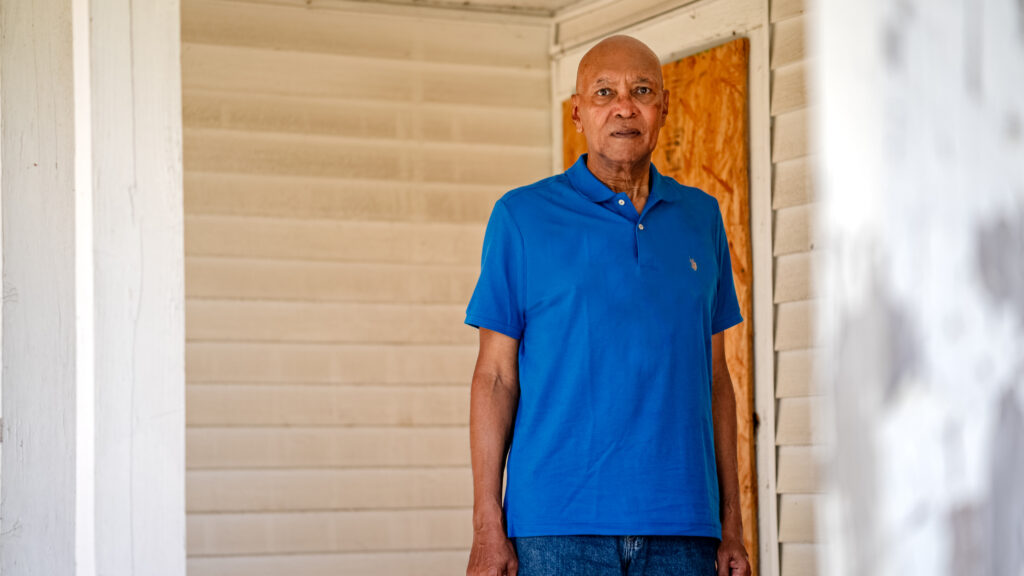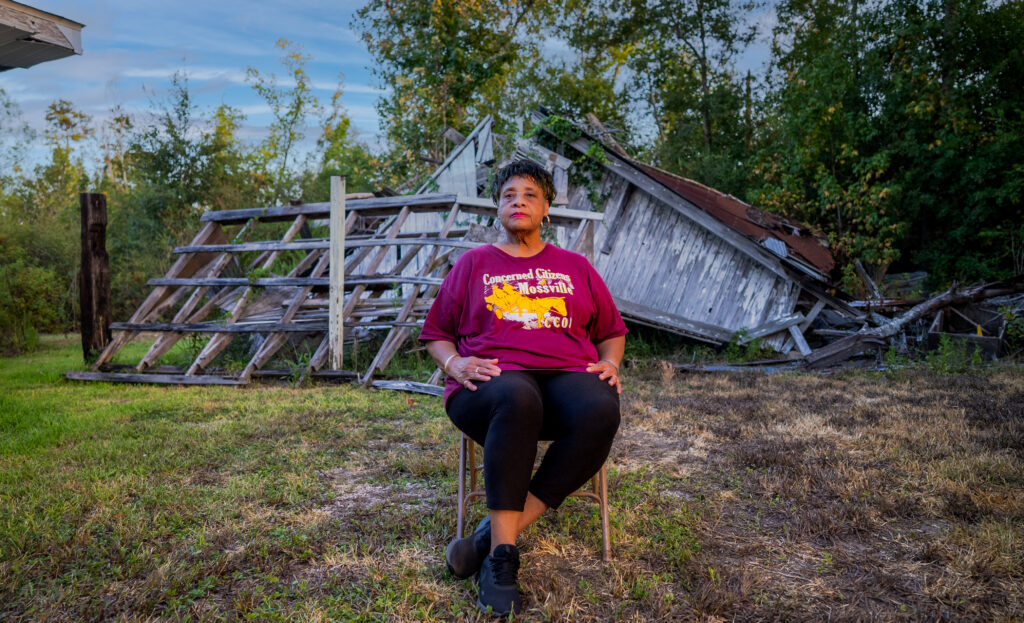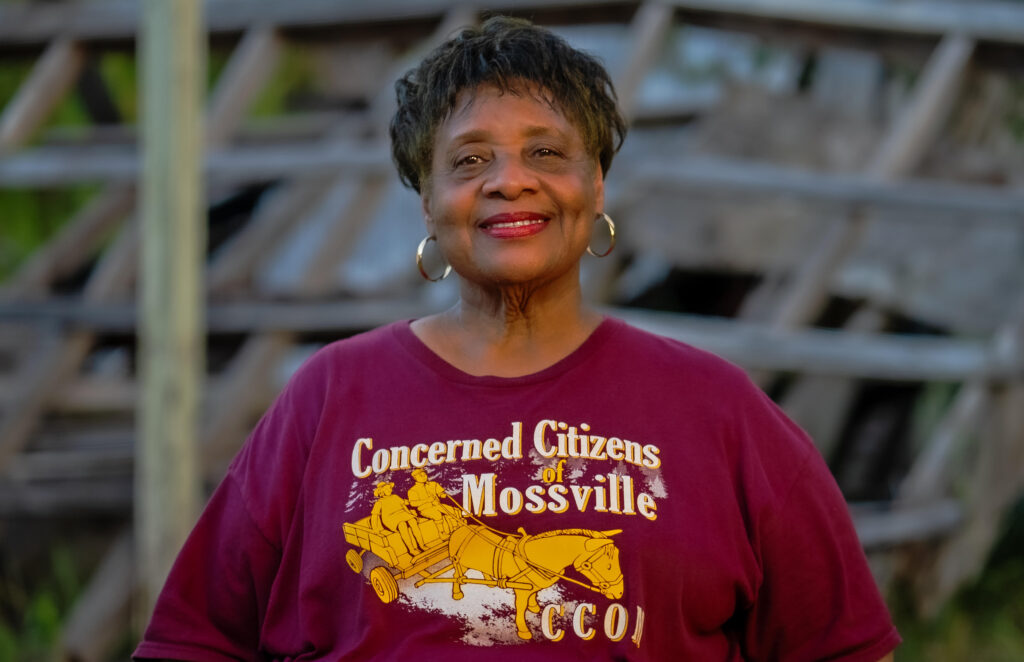Mossville, a historically Black community in Southwest Louisiana, founded by enslaved people, was once home to a thriving and self-sustaining community. As Stafford Frank, who grew up in Mossville, reflects, “We had over 500 families in Mossville. We had neighborhood stores, a high school, barbershops, cleaners, churches, a recreation center with swimming pool, and a bus line. We had the Paradise Club that featured famous Black entertainers including James Brown, Aretha Franklin, Solomon Burke, and Otis Redding. This was a rich community – not some fly by community. The bottom line is we had well-kept homes, we raised animals, raised our own vegetables, and had good fishing and hunting. That’s why people moved to Mossville.”

Stafford Frank, resident of Mossville. Photo credit Oxfam International.
That community has been decimated to less than 50 families due to the operations of South African petrochemical giant, Sasol. Now Mossville fears the idea of history repeating itself and that another historic Black fence line community will be destroyed by Sasol and other companies without any justice.
Since the 1940s, Mossville has been constantly subjected to heavy emissions from over a dozen industrial facilities. These industrial facilities have increasingly encroached Mossville’s boundary lines. This includes the massive Lake Charles Sasol Chemical Complex, which has been in operation since 2001 after Sasol purchased the facility from Condea Vista.
The Sasol plant emits thousands of pounds of toxic chemicals into the air, soil, and water each year, poisoning these essential resources and risking the health of those who live there.
Residents are particularly concerned about Sasol’s emissions of the highly carcinogenic chemical ethylene oxide. In 2021 and 2022, the Sasol plant emitted thousands of pounds of ethylene oxide – a concerning amount given that research supports that no level of exposure to ethylene oxide is safe.
With emissions from Sasol’s facilities already at dangerous levels, Sasol announced plans for a major expansion of its Lake Charles plant in 2011. It began constructing its new facilities in 2014, building on top of land that had once housed Mossville residents’ homes and community spaces. This expansion threatens to worsen emissions and expand their reach even further into the Mossville community. Yet, Louisiana’s Department of Environmental Quality permitted the expansion and failed to step in to protect Mossville residents’ right to clean air. Now, Concern Citizens of Mossville (CCOM) are calling on “all local, state and federal agencies to abandon their old way of thinking and ineffective policies that no longer work, to protect lives and environment. Environmental Protection Agency law makers must think outside the box to move with urgency in behalf of fence line communities, under vicious attack by industry.”

President of Concerned Citizens of Mossville. Photo credit Oxfam International.
Sasol’s Buyout Program
Facing public scrutiny over its unsafe emissions, Sasol opened a home buyout program for communities located near its Lake Charles Chemical Complex in 2013. This program recognized that Mossville and other communities near its Complex were becoming increasingly uninhabitable, especially with the onset of its 2014 expansion.
Although Sasol asserts that the residents’ decision to sell their homes through the buyout program was fully voluntary, as a 2021 study by the University Network for Human Rights found, many Mossville residents “experienced the [buyout] as forced displacement.” Mossville residents were left with “an impossible choice”: (1) leave their homes and community or (2) continue to risk their lives and health, by continuing to live near the Sasol facility.
The study confirmed that for many Mossville residents, Sasol’s buyout offers were much too low to fund the purchase of a similar home in another area. Many residents ultimately accepted inadequate offers and were forced to relocate to homes of lesser quality. Others felt that they had no choice but to remain in their homes because of offensive offers from Sasol’s buyout, which left them subjected to Sasol’s toxic emissions and in an area that had subsequently become a ghost town.
Moreover, the University Network for Human Rights’ 2021 study found that Sasol’s buyout offers to residents of Mossville, a community that was 90% Black, were significantly lower – 45% on average – than Sasol’s offers to residents of the neighboring area of Brentwood, a community that was 90% white.
“It was heart-wrenching to see the disparity between how our Black neighborhood was treated as compared to how the white neighborhood was treated, and they lived right next door to us,” said Carolyn Peters, president of CCOM. “That is just one of the horrors that our community faces every day.”

Carolyn Peters, President of Concerned Citizens of Mossville. Photo credit Oxfam International.
A pattern of environmental racism
The discriminatory buyout program in Louisiana is just the latest chapter in Sasol’s long history of race discrimination allegations and disregard for human rights.
In the 1970s, the expansion of Sasol’s facilities and development of a new residential area for its white employees in Secunda, South Africa, led to the forced displacement of Black South Africans from the village of Driefontein to eMbalenhle, a township located downwind, from the Sasol plant and near coal mines – ripping them from their land and homes and subjecting them to dangerous emissions.
At this Secunda facility, Sasol used technology developed in Nazi Germany to convert coal to liquid fuel, ensuring Apartheid South Africa’s energy security. In this way, Sasol was not only helping ensure the longevity of the Apartheid system in South Africa in the face of international sanctions, but it was doing so — and continues to do so— using one of the most polluting liquid fuel production processes in the world.
Even though several decades and thousands of miles separate Sasol’s forced displacement of Black South Africans to eMbalenhle and Sasol’s racially discriminatory buyout program in Mossville, the plight of the residents who continue to reside in the shadow of these Sasol facilities is strikingly similar.
Sasol’s Secunda plant is the largest single source of greenhouse gas emissions globally – emitting more from a single facility than over 100 nations. The Secunda facility also releases toxic pollutants, with emissions from Sasol’s Secunda plant estimated to be responsible for 17% of hospital admissions in Mpumalanga Province and as many as 72 deaths every year.
Sasol is also facing criminal charges for allegedly intentionally dumping hazardous waste from its Secunda facility into the Vaal River, a waterway on which approximately 19 million people depend.

Lake Charles, Louisiana, home of Sasol’s Lake Charles Chemical Plant.
In Mossville, Sasol’s Lake Charles Chemical Plant was ranked as the #2 “super polluter” facility, based on its release of carcinogens, metals, and other toxic chemicals into the air. Mossville ranks in the 94th percentile for air toxic cancer risk nationwide. A study by the Agency for Toxic Substances and Disease Registry found heightened levels of highly toxic dioxins in Mossville residents’ blood. Also, Mossville residents experience some of the highest cancer risk rates in Louisiana – as high as those endured by communities in “Cancer Alley” located over two hours away from Mossville.
Sasol cannot continue its long Apartheid legacy of displacing Black communities and poisoning those who remain. Today, the company has the opportunity and the obligation to change course. Mossville residents, organized as CCOM, are demanding a just and equitable relocation package for those who want to leave. “It’s never too late to do the right thing,” said Ms. Peters. “After subjecting us to decades of toxic chemicals and displacing much of our community, now is the time to do the right thing, to provide Mossville residents with an equitable relocation buyout that we so desperately deserve.”
CCOM joined human rights defenders standing up to pollution in South Africa and Colombia to share the story of Mossville in “Hold the Line,” a film produced by Oxfam. As Ms. Peters notes, “Remember Sasol, the world is watching!”
Learn more about Sasol’s legacy of environmental racism in Oxfam’s new film, Hold the Line, where former residents of Mossville share their story of standing up to this petrochemical giant





